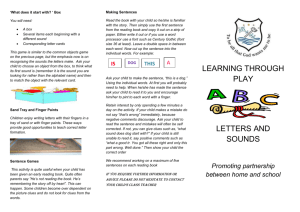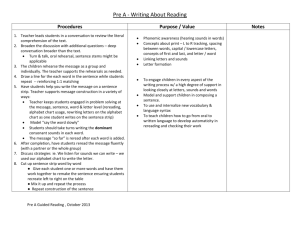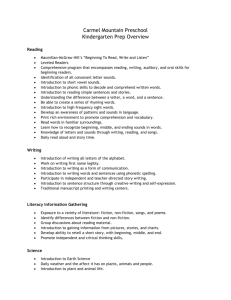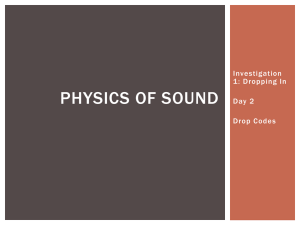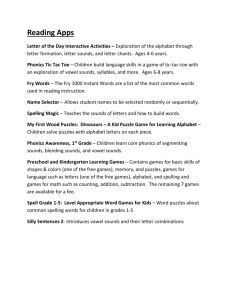Helping your child to read - Aughton Christ Church C of E Voluntary
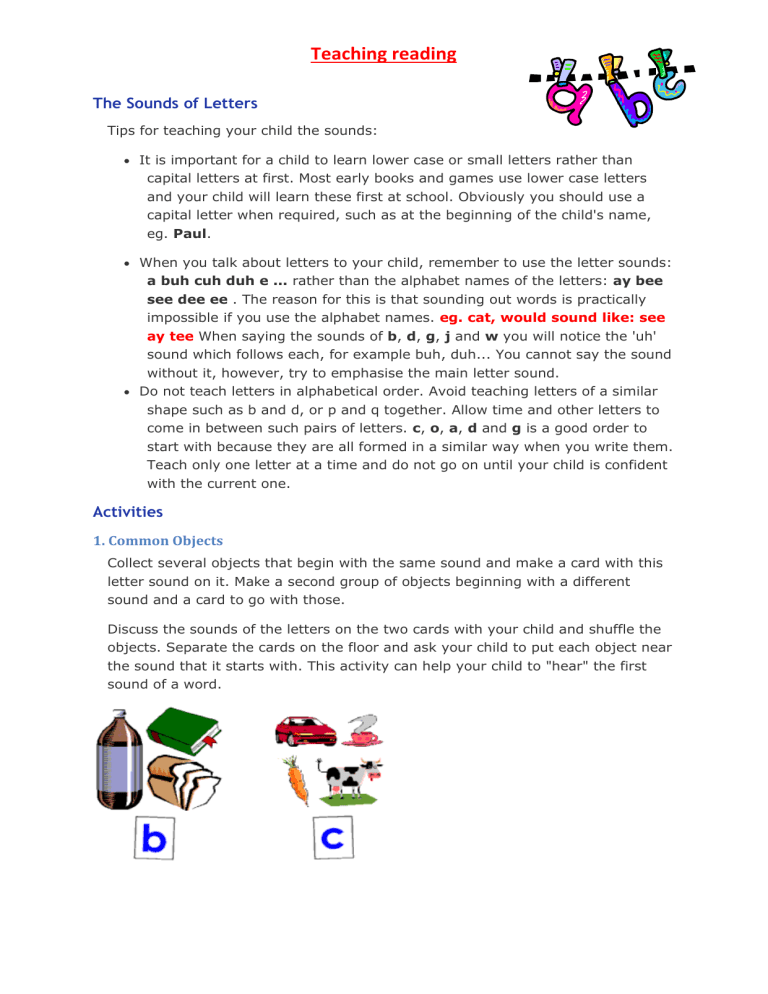
Teaching reading
The Sounds of Letters
Tips for teaching your child the sounds:
It is important for a child to learn lower case or small letters rather than capital letters at first. Most early books and games use lower case letters and your child will learn these first at school. Obviously you should use a capital letter when required, such as at the beginning of the child's name, eg. Paul.
When you talk about letters to your child, remember to use the letter sounds:
a buh cuh duh e ... rather than the alphabet names of the letters: ay bee
see dee ee . The reason for this is that sounding out words is practically impossible if you use the alphabet names. eg. cat, would sound like: see ay tee When saying the sounds of b, d, g, j and w you will notice the 'uh' sound which follows each, for example buh, duh... You cannot say the sound without it, however, try to emphasise the main letter sound.
Do not teach letters in alphabetical order. Avoid teaching letters of a similar shape such as b and d, or p and q together. Allow time and other letters to come in between such pairs of letters. c, o, a, d and g is a good order to start with because they are all formed in a similar way when you write them.
Teach only one letter at a time and do not go on until your child is confident with the current one.
Activities
1. Common Objects
Collect several objects that begin with the same sound and make a card with this letter sound on it. Make a second group of objects beginning with a different sound and a card to go with those.
Discuss the sounds of the letters on the two cards with your child and shuffle the objects. Separate the cards on the floor and ask your child to put each object near the sound that it starts with. This activity can help your child to "hear" the first sound of a word.
Teaching reading
2. Odd-one Out
Say a number of words, all but one of which begin with the same sound. See if your child can pick out the odd one. It can be helpful to have the corresponding objects there for the child to look at.
W
hich starts with a different sound to the others?
3. Sounds Scrapbook
Write a letter at the top of each page of a scrapbook. Concentrating on a few letters at a time collect pictures of objects that begin with those letters. Do not use as examples words where the first sound does not make its normal sound such as in giraffe, ship, cheese, thumb. Stick the pictures on the appropriate pages.
4. I-Spy
For small children the usual way of playing that starts 'I spy with my little eye something that begins with ....' can be too difficult. You can make this easier by providing a clue. 'I spy with my little eye something that barks and begins with duh'.
Teaching reading
Recognising Letter Shapes
1. Fishing for Sounds
You will need a few cards with individual letters. Attach a paper clip to each card.
Using a small stick with a string and magnet, your child fishes for letter sounds. If your child can say the sound of the letter he/she wins the card, otherwise you win it.
2. Sequencing the Letters in your Child's Name
Providing the individual letter cards for each letter of your child's first name can be a useful way to teach the sequence of letters. Remember you will need to write a capital for the first letter and lower case for the rest. If you want to print out the cards using a word processor use a font such as Century Gothic on PC which has not a . Show your child how to make the name first, before shuffling the cards for him/her to have a try. For a very long name work with the first few and build up a letter at a time.
3. 'What does it start with?' Box
You will need:
A box
Several items each beginning with a different sound
Corresponding letter cards
This game is similar to the common objects game on the previous page, but the emphasis now is on recognising the sounds the letters make. Ask your child to choose an object from the box, to think what its first sound is (remember it is the sound you are looking for rather than the alphabet name) and then to match the object with the relevant card.
Teaching reading
4. Sand Tray or Finger Paints
Children enjoy writing letters with their fingers in a tray of sand or with finger paints. These ways provide good opportunities to teach correct letter formation.
Whole Sentence Activity
This activity is quite useful when a child has been given an early reading book from school or nursery. Quite often parents say "He's not reading the book. He's remembering the story off by heart". This can happen. Some children become over-dependent on the picture clues and do not look for clues from the words.
Making Sentences
Read the book with your child so he/she is familiar with the story. Then simply use the first sentence from the reading book and copy it out on a strip of paper. Either write it out or if you use a word processor use a font such as Century Gothic (font size 36 at least). I suggest this font because it is important to use one that is similar to your child's reading book. Leave a double space in between each word.
Now cut up the sentence into the individual words. For example:
Ask your child to make the sentence, "This is a dog.", using the individual words.
At first you will probably need to help. When he/she has made the sentence ask your child to read it to you and encourage him/her to point to each word with a finger.
When he/she can sequence one sentence, you can introduce the next sentence from the book. Ask your child to read them both.
Retain interest by only spending a few minutes a day on the activity. If your child makes a mistake do not say "That's wrong" immediately, because negative comments discourage. Ask your child to read the sentence and mistakes will often be self-corrected. If not, you can give clues such as, "What sound does dog start with?" If your child is still unable to read it, say positive comments such as "What a good try. You got all these right and only this part wrong. Well done." Then show your child the correct order.
Teaching reading
I recommend working on a maximum of five sentences on each reading book. This method is useful for teaching children to look for the first sound of a word.
When your child becomes more proficient and can recognise a number of words, you can play a game with some of them. Have a little 'competition' with your child. Stack the individual words in a pile and ask you child to read them one at a time. If the word is read successfully, your child wins the card. If not, you win it.
Children enjoy beating adults and it is more fun than just saying, "Read these words".
Helping your child to read
1. Choose a quiet time
Set aside a quiet time with no distractions. Ten to fifteen minutes is usually long enough.
2. Make reading enjoyable
Make reading an enjoyable experience. Sit with your child. Try not to pressurise if he or she is reluctant. If your child loses interest then do something else.
3. Maintain the flow
If your child mispronounces a word do not interrupt immediately. Instead allow opportunity for self-correction. It is better to tell a child some unknown words to maintain the flow rather than insisting on trying to build them all up from the sounds of the letters. If your child does try to 'sound out' words, encourage the use of letter sounds rather than 'alphabet names'.
4. Be positive
If your child says something nearly right to start with that is fine. Don't say 'No.
That's wrong,' but 'Let's read it together' and point to the words as you say them.
Boost your child's confidence with constant praise for even the smallest achievement.
5. Success is the key
Parents anxious for a child to progress can mistakenly give a child a book that is too difficult. This can have the opposite effect to the one they are wanting.
Remember 'Nothing succeeds like success'. Until your child has built up his or her confidence, it is better to keep to easier books. Struggling with a book with many unknown words is pointless. Flow is lost, text cannot be understood and children can easily become reluctant readers.
6. Visit the Library
Encourage your child to use the public library regularly.
Teaching reading
7. Regular practice
Try to read with your child on most school days. 'Little and often' is best. Teachers have limited time to help your child with reading.
8. Communicate
Your child will most likely have a reading diary from school. Try to communicate regularly with positive comments and any concerns. Your child will then know that you are interested in their progress and that you value reading.
9. Talk about the books
There is more to being a good reader than just being able to read the words accurately. Just as important is being able to understand what has been read.
Always talk to your child about the book; about the pictures, the characters, how they think the story will end, their favourite part. You will then be able to see how well they have understood and you will help them to develop good comprehension skills.
10. Variety is important
Remember children need to experience a variety of reading materials eg. picture books, hard backs, comics, magazines, poems, and information books.
